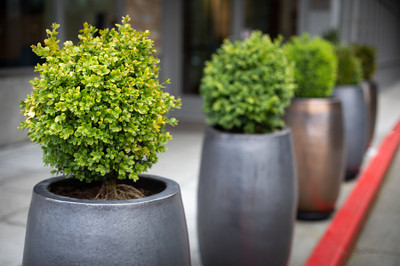The PPM Guide to Planting Trees in Pots
Posted by Jason Wyrwicz on Oct 7th 2022
Using pots and planters to house trees is easier than you might think, and wide varieties are well suited to these types of containers. Trees bring color and texture to any environment and often become the main focal point. If you lack space to plant trees in the ground, pots and planters are a feasible solution so long as they are compatible with the local climate and your home’s environment.
Here are some essential things to consider when planting trees in pots.
Size matters
Before you plant, make sure you do your research on the maximum size of the tree species you are considering and how long it takes until it reaches full maturity. Doing this can avoid nasty surprises when the tree outgrows the pot and requires an impossible extraction.
Trees have thirsty roots, unlike smaller plants, like shrubs, flowers, or cacti, so ensuring you have the right-sized pot is a no-brainer. At Pots, Planters, and More, we provide growers with a range of containers that vary in volume, width, and depth. In general, pots and planters need to be larger for trees to maximize root run, adequate moisture, and nutrient levels.
Soil and Water
Trees planted in pots or planters almost always dry out faster than those grown in the ground. The only way to ensure your tree stays happy and healthy is to water it often and in more significant quantities. Trees that reside on a patio or indoors will receive considerably less precipitation, so the task of keeping them hydrated falls to you. Leaving your trees unattended for extended periods can have some terrible consequences!
The same goes for fertilizer. To prevent a lack of nutrients, replace the top layer of compost as and replace it with fresh, loam-based compost to revitalize the soil and boost growth. Regularly feeding the soil in the summer months will also help prevent rot and decay.
Planting trees in pots can actually be advantageous as you can control the soil type at all times and promote growth more effectively.
Many clients we have spoken to have been able to manipulate growing conditions to suit the types of trees they prefer. Whether it be acid-loving varieties in chalky soil or popular trees like Japanese Maples and Crab Apple in heavy clay soil—your trees will thrive for many years if tended to with care.
We recommend planting more evergreen trees than deciduous species, as pots don’t allow for as much insulation deciduous roots. That doesn’t mean that all deciduous varieties are off the menu. It just means that you will need extra care during the winter months to keep them warm.
Portability = Longevity
Another great advantage of planting trees in pots or planters, is that you can move them inside or to a sheltered area during the colder months to shelter them from frost and snow. The inverse is true if you live in a hotter climate, as shade will prevent wilting and damage to foliage. Also, if you are really in love with your trees but need to move house, just pick them up and take them with you. Voila!
It is essential also to consider the effect certain pests have on tree species. Especially at the change of seasons, insects can quickly turn your lovely potted trees into an eyesore. Both indoors and outdoor trees are susceptible to pests. Therefore, it is best to understand the kinds of creepy crawlies that inhabit your area and whether you need to move your plants around to avoid an infestation.
If you can’t be bothered moving your plants around despite extreme conditions, make sure you select trees that can withstand whatever mother nature throws at them. A great resource to use is the USDA Plant Hardiness Map, the standard by which gardeners and growers can determine which plants are most likely to thrive in different regions of the country.
Brightens and Livens Up Any Space!
Trees are a great addition to a patio, entertaining outdoor area, or open plan home. Trees also have practical uses—try using them in a row as a boundary or privacy screen. We love seeing potted trees define outdoor and indoor spaces. They can be useful on either side of a doorway, alongside a sidewalk entrance, or at the end of a driveway to accentuate entryways. Moreover, trees add texture, color, order, and dimension—a quadruple threat that other plants can't perform.
Each species of tree will have different light requirements. Insufficient light can cause leaves to stress and fruit to underperform, so ensure you understand their lighting needs before setting them down.
To re-pot or not?
Depending on the tree, you may need to repot your tree into a larger pot after four or five years. Users can cherish many months of shade, foliage, and blooms by investing in slower-growing trees, making them a better investment than varieties that quickly outgrow a planter or pot.
The one thing that differs significantly from other plants is root pruning. Some owners undertake this laborious process, replanting the tree into the same pot with fresh compost. Doing this saves money on purchasing a new pot but can take quite a while to get right and can cause the tree to die if not done correctly. The basic process is to take the tree out of the pot and lightly pull the roots apart. After this is done, trim the roots down similarly to tree branches, return them to the pot, and replace any lost soil.
If you are considering planting trees in pots or planters to liven up your indoor or outdoor space, why not get in touch and check out what we have to offer? We would love to assist you!



